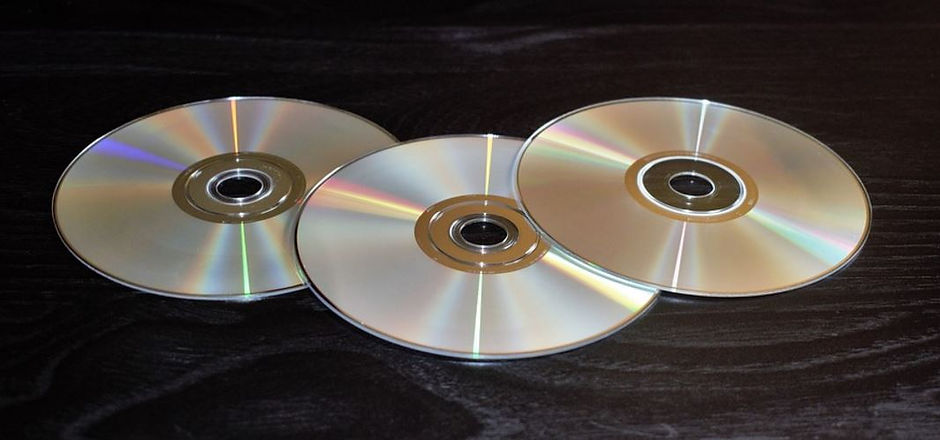
The DVD’s greater capacity is due to three differences from CDs
Bit are packed more closely on a DVD. The spacing between loops of a spiral on a CD is 1.6 micrometer and the minimum distance pits along the spiral is 0.834 micrometer The DVD achieves a loop spacing of 0.74 micrometer and a minimum distance between pits of 0.4 micrometer
The DVD employs a second layer of pits and lands on top of the layer and by adjusting focus. This technique almost doubles the capacity of the disk
The DVD-ROM can be two sided whereas data is recorded on only one side of a CD.

The electronics industry has at last found an acceptable replacement for the analog VHS video tape. The DVD will replace the video tape used in video cassette recorders (VCRs) and replace the CD-ROM in personal computers and servers. The DVD takes video into the digital age. It delivers movies with impressive picture quality and it can be randomly accessed like audio CDs. DVD’s huge storage capacity and vivid quality. PC games will become more realistic and educational software will incorporate more video.
DIGITAL VERSATILE DISK (DVD)

CD Rewritable
The CD-RW optical disk can be repeatedly written and overwritten. The only pure optical approach that has proved attractive is called phase change. The phase change disk uses a material that has two significantly different reflectivity in two different phase static. There is an amorphous state and a crystalline state. A beam of laser light can change the material from one phase to the other. The primary disadvantage of phase change optical disks is that the material eventually and permanently loses its desirable properties.
The CD-RW has the obvious advantage over CD-ROM and CD-R that it can rewritten and thus used as a true secondary storage.
CD Recordable(CD-R)
To accommodate applications in which only one or a small number of copies of a set of data is needed. The write-one read -many CD. A disk is prepared in such a way that it can be subsequently written once with laser beam of modest intensity. The customer can write once as well as read the disk.
The CD-R medium is similar to but not identical to that of a CD of CD-ROM information is recorded by the pitting if the surface of the medium. The medium includes a dye layer. The dye layer is used to change reflectivity and is activated by a high-intensity laser.
The CD-R optical disk is attractive for archival storage of documents and files.

The advantages of CD-ROM are as follows:
The optical disk together with the information store on it can be mass replicates inexpensively—unlike a magnetic disk. The database on magnetic disk has to be reproduced by copying one disk at a time using two disk drives.
The optical disk is removable, allowing the disk itself to be used for archival storage.
The disadvantages of CD-ROM are as following:
It is read-only and cannot be updated.
It has an access time much longer than that of a magnetic disk drive, as much as half a second.

To achieve greater capacity CD and CD-ROMs do not organize information on concentric tracks. Instead, the disk contains a signal a single tracks. Information is packed evenly across the disk in segments of the same size and these are scanned at the same rate by rotating the disk at a variable speed. The pits are then read by the laser at a constant linear velocity (CLV). The data capacity for a CD-ROM is about 680 MB.
Data on the CD-ROM are organized as a sequence of blocks. A typical block format is shown in Figure 6.11. It consists of the following field:
Sync: The sync field identifies the beginning of a block. It consists of a byte of all 0s, 10 bytes of all 1s, and a byte of all 0s
Header: the header contain the block address and the mode byte. Mode 0 specifies a blank data field; mode 1 specifies the use of an error-correcting code and 2048 bytes of data; mode 2 specifies 1336 bytes of user data with no error-correcting code.
Data: user data.
Auxiliary: Additional user data in mode 2. In mode 1, this is a 288-byte error-correcting

Both the audio CD and the CD-ROM (compact disk read-only memory) share a similar technology. The main difference is that CD-ROM players are more rugged and have error correction devices to ensure that data are properly transferred from disk to computer.
Information is retrieved from a CD or CD-ROM by a low-powered laser house in an optical-disk player, or drive unit. The laser shines through the clear polycarbonate while a motor spins the disk past it (Figure 6.10). The intensity of the reflected light of the laser changes as it encounters a pit. The change between pits and lands is detected by a photosensor and converted into a digital signal, when no change in elevation occurs between intervals, a 0 is recorded.
COMPACT DISK
CD-ROM

In 1983, one of the most successful consumer products of all time was introduced: CD (the compact disk) digital audio system. The CD is a nonerasable disk that can store more than 60 minutes. A variety of optical-disk system have been introduced.


